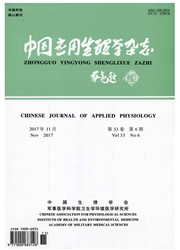

 中文摘要:
中文摘要:
目的:探讨建立一种新型的脂肪变性人肝癌细胞(HepG2)模型,观察核因子E2相关因子2(Nrf2)/抗氧化反应元件(ARE)通路相关因子在脂肪变性HepG2细胞中的表达及其意义。方法:HepG2细胞给予含25%的胎牛血清、0.1%医用脂肪乳和0.1 mmol/L游离脂肪酸(FFA)的DMEM培养基分阶段诱导后,建立脂肪变性HepG2细胞模型,并设置对照组。模型成功后,以油红O染色观察细胞内脂滴形成状况,并用全自动生化仪检测细胞内甘油三酯(TG)含量;采用流式细胞仪测定细胞内活性氧(ROS)的含量,采用生物试剂盒检测细胞内一氧化氮(NO)、超氧化物歧化酶(SOD)、丙二醛(MDA)、谷胱甘肽过氧化物酶(GSH-Px)含量及活性的变化;运用Western blot法检测各组细胞Nrf2、血红素氧化酶-1(HO-1)和醌氧化还原酶1(NQO1)蛋白的表达。结果:与对照组比较,模型组油红O染色可见细胞内橘红色脂滴大量形成,TG、ROS、NO、MDA含量水平明显增高(P〈0.05,P〈0.01),SOD、GSHPx活性明显下降(P〈0.01),Nrf2、HO-1和NQO1蛋白表达均显著增高(P〈0.05,P〈0.01)。结论:本模型可以成功诱导HepG2细胞发生脂肪变性和氧化应激损伤状态;Nrf2/ARE通路下游相关因子发生激活可能与脂肪变性HepG2细胞氧化应激的过度反应有关。
 英文摘要:
英文摘要:
Objective: To explore a new method of establishing HepG2 cell model of steatosis and observe the expression and significance of nuclear factor erythroid-2p45-related factor 2( Nrf2)/antioxidative response element(ARE )pathway related factors in HepG2 cells of steato- sis. Methods: HepG2 cells were induced with DMEM containing 25 % fetal bovine serum, 0.1% MCT/LCT Fat Emulsion and 0.1 mmol/L free fatty acid (FFA) at different stages and the control group cells were cultured with normal DMEM medium. After the cell models were suc- cessfully established, lipid droplets in cytoplasm were observed with Oil Red O staining, and the triglyceride(TG) accumulation in HepG2 cells were tested by biochemical assay. Intracellular reactive oxygen species (ROS) concentration were detected by flow cytometry. Nitric oxide (NO), supemxide dismutase(SOD), malonyldialdehyde(MDA) and glutathione peroxidase(GSH-Px) were tested by biological reagent kit, while the protein expression of nuclear factor erythroid-2p45-related factor 2(Nrf2), heme oxygenase-l(HO-1) and NAD(P)H: quinone oxi-doreductase- 1 (NQO1) were analyzed by Western blot. Results: Compared with that in the control group, red cytoplasmic lipid droplets were visible in model group; TG, ROS, NO, MDA concentration ( P 〈 0.05, P 〈 0.01 ) and the protein expression of Nrf2, HO- l and NQO1 ( P 〈 0.05, P 〈 0.01 )were significantly higher in model group, while SOD, GSH-Px concentration reduced significantly( P 〈 0.01 ). Conclusion: The in vitro cell model of steatosis and oxidative stress was successfully established. The activation of Nrf2/ARE pathway related factors maybe relevant to the overreaction of oxidative stress in HepG2 cells of steatosis.
 同期刊论文项目
同期刊论文项目
 同项目期刊论文
同项目期刊论文
 期刊信息
期刊信息
